Q4 2005, Parallel Filters
As the previous filters didn't provide satisfying results, we made a switch to parallel filters, because parallel filters provide more freedom in making design trade-offs. There are always heated debates about the superior characteristics of series or parallel filtersMadisound
Madisound offers a nice design service on their website. As the price for such a design seems to be quite reasonable ($40), we took this opportunity. They've create the design based on their own unit measurements. The resulting filter is the following: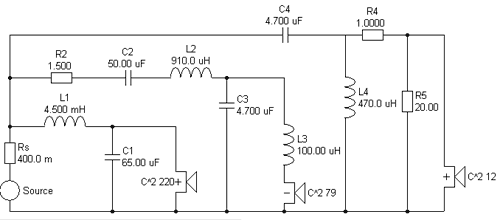
According to their circuit simulation and measured curves, the response looks as follows:

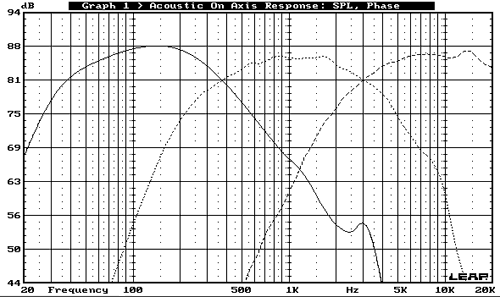
But the sound is thin, resonating and not involving. Observing the filter using our own anechoic measurements shows the following response. The response shows no baffle-step compensation. The woofer curve is not properly attenuated between 200 and 1kHz, and requires compensation. Especially the overlap at 400Hz between woofer and midrange looks bad. The tweeter also doesn't slope smoothly, as can be seen between 2 and 5kHz.
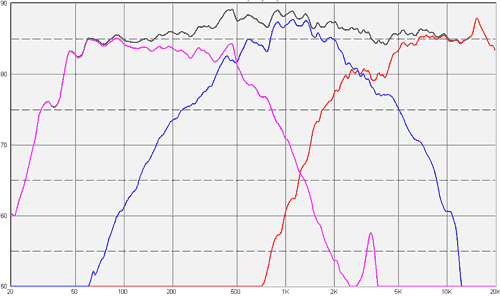
My own in-house measurements support the anechoic simulations (except for low frequencies where I can't measure properly, and that I haven't applied felt on the baffle during these measurements, so the dip at 4.3kHz and the peak at 8.6kHz are more pronounced).

When gating the measurement (excluding the < 200Hz region, and smoothing the low frequency region as opposed to the high frequency region), the measurement looks as follows:

This again show the importance of having good unit measurement curves (anechoic and measured inside the enclosure) as a starting point for filter design.
Paul Vancluysen
Peter Michiels, a colleague at work, brought me in contact with Paul Vancluysen, an experienced speaker designer. Paul designed a filter for the Milestones, based on my own in-house measured curves (appr. 50cm distance from the foot of the baffle, each unit measured on-axis at its respective altitude). This resulted in the following filter (click on the filter for magnification):
The explanation of Paul is as follows (translated from Dutch, or should I say Flemish?):
The most important assumptions and constraints are:
- The units must have a quasi-identical phase response (same delay) around the crossover frequency.
- Higher-order filters have been used to minimize the overlap between the units regarding their polar response (especially for the tweeter and midrange), and to filter the breakups of the units (woofer and midrange)
- Preference of all units in phase.
- Flatten the power response as much as possible, which also implies a flat impedance response.
The design in summary:
- Low and mid
Marc said the woofer colors when its mid region is not filtered strongly, and therefore I started with a 4th order woofer filter. Electrical this is a Linkwitz-Riley concept, with its crossover at roughly 350Hz. The midrange in its enclosure has a resonance around 125Hz, where its phase is leading compared to the phase of the woofer. For that reason, a 3rd order lowpass section is chosen for the midrange (C3, C4 and L3), This filter has been tuned to meet the constraints regarding phase, amplitude and impedance. I took extreme care that the midrange filter did not have resonant rise symptoms. I haven't been able to get midrange and woofer in perfect phase, because delay slightly increases and decreases at the crossover frequency. But the phase of the woofer smoothly approaches the phase of the midrange, the amplitude is reasonably flat, and the impedance increases to a maximum of 10 Ohms at the crossover point, hence the power response is about 2dB lower. Maybe there is room for improvements here, but it is not easy, and we have to choose for a compromise. The woofer filter is close to the resonance of the woofer in its enclosure, resulting in resonance, too much we think. We will dampen the system impedance in the future.
- Mid and treble
From previous speaker designs I have good experience with 4th-order filters for tweeters. Subsequently, the treble region of the midrange requires filtering, and the phase of both speakers must be aligned, also implying a higher order filter for the tweeter. This has positive effect on the polar response when operating together with the midrange. Therefore, a 2nd order low-pass filter is chosen for the midrange, and a 4th order high-pass filter for the tweeter. The second order section L6, C6 of the midrange filter is tuned. Care has been taken to filter the rising response at 1kHz, not to resonate, and to match the phase with the tweeter. The compensation network R5, C5, L5 has been added to prevent resonances. Because of this, the impedance of the low-pass section becomes resistive for the high-pass section, so that it can be connect in front to obtain a nice midrange filter. This section requires some more tuning, because the slope above 1kHz is a bit too strong. But this will be another compromise, as the 1kHz peak also requires maximum filtering. An experiment has been performed with a band-rejection filter, favorable regarding simulation, but not resulting in good sound.
The sound characteristics of the filter are quite nice. Some observations (also compared to the previous filters):
- More 3D perspective. The sound is "loose from the speakers". You can hear stereo in the whole room.
- The bass has drive and fun.
- The units integrate nicely, and sound as a whole.
- Dynamic sound, it has quite some reserve.
- The harsh sound that is many times associated with Thiel units is mostly gone.
- Good seperation of sound sources, even with complex pop mixes.
But:
- It is significantly resonating in the mids, from 900Hz - 1kHz. Very obvious with piano music.
- An overall baritone sound character (nasal).
- The bass is too strong on pop recordings. Instead of "pop" it does "bob" on deep base-drums.
- Despite the bass, the overall sound is small, and lacks fundament. It is not "musical" because it misses some drive.
- Treble has an edge. There is sibilance on 's'-sounds of voices.
The anechoic curves show the following response:
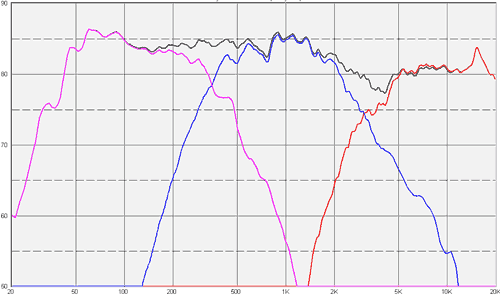
As one can see, the midrange curve slowly rises 3dB from 150Hz to 900Hz, remains at its max at 1.5kHz, and then drops 7dB to 4kHz. That explains the baritone sound, emphasizing the midrange. The peak at 12kHz might explain the sibilance.
Measurements are inline with the simulation above:

The gated measurement (dip at 300 is reflection, roll-off at 15kHz is measurement equipment):
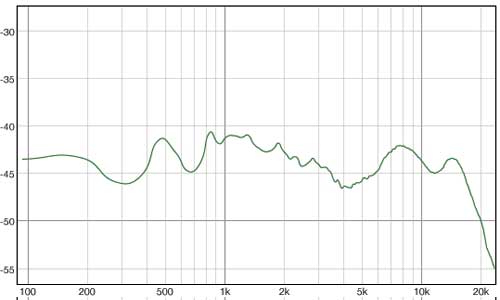
Impedance curve:

Phase inversion of the midrange show good phase behavior:
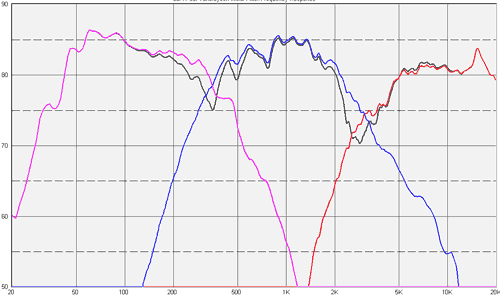
And finally, an impression of the built filter to show that 4th-order filters are not really compliant with the external cases we've made.
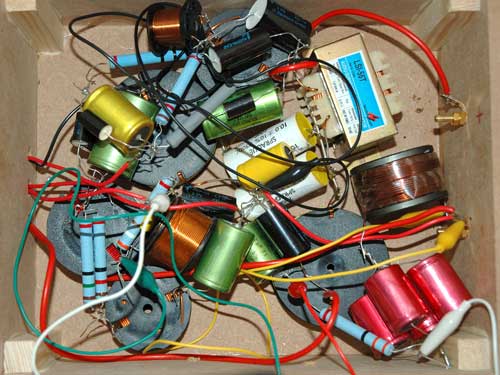
We've tried all kind of improvements to Paul's filter, like rejection filters and impedance compensations to eliminate the peak of the woofer. These changes had some effect, but didn't provide the changes we were looking for. We've also experimented with new unit curves, but so far nothing seemed to solve the points we'd liked to solve.
next->